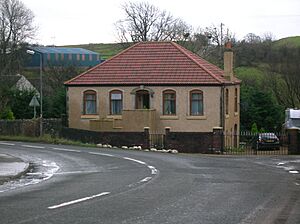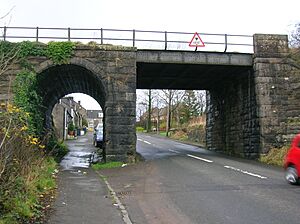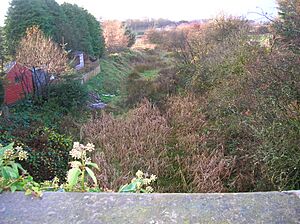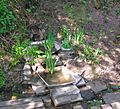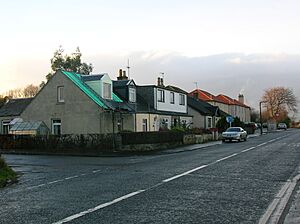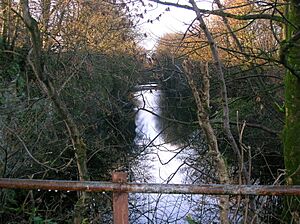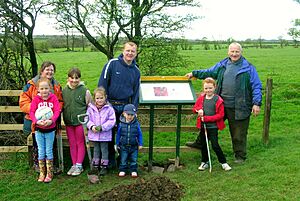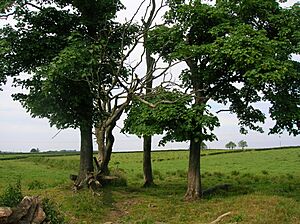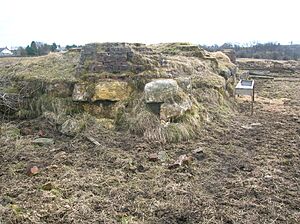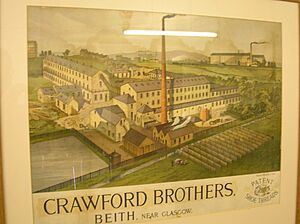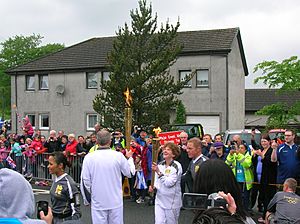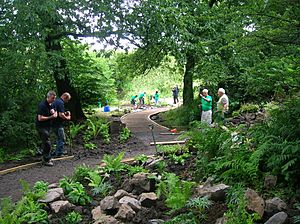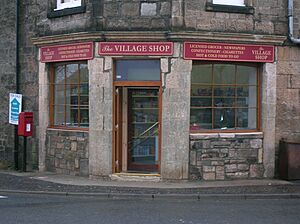Barrmill, North Ayrshire facts for kids
Quick facts for kids Barrmill |
|
|---|---|
 Barrmill from the old railway bridge |
|
| Council area | |
| Lieutenancy area |
|
| Country | Scotland |
| Sovereign state | United Kingdom |
| Dialling code | 01505 |
| Police | Strathclyde |
| Fire | Strathclyde |
| Ambulance | Scottish |
| EU Parliament | Scotland |
| UK Parliament |
|
| Scottish Parliament |
|
Barrmill is a small village in North Ayrshire, Scotland. It's about 1.5 miles (2.4 km) east of Beith, on the road to Burnhouse and Lugton. People who live there sometimes call it the Barr.
Contents
History of Barrmill
Barrmill started as a small farming area. In the past, it grew into a village because of jobs from local industries. These included several quarries that dug up limestone (a type of rock) and an ironstone pit.
In the mid-1800s, a factory was built to make linen thread. This thread was used for making boots, shoes, and sails. The village population grew from 300 people in 1876 to 600 in 1951. Even after the thread factory closed, many workers still lived in company houses. They were taken by bus to a bigger thread factory in Kilbirnie. The main factory buildings have been taken down, but the old offices are still there.
The limestone works in Barrmill closed in 1972. There were also quarries that dug up whinstone (another type of rock), but these were almost empty by 1951. An old coal mine called Giffen coal pit closed around the late 1890s.
In 1912, there was a place for playing quoits (a game like horseshoes) near the old railway. A new group of houses was built in 2006 where the old Barrmill railway station used to be.
Barrmill Railway Station
Barrmill railway station was a stop on the railway line that went from Lugton to Beith Town. It opened on June 26, 1873. Passenger trains stopped using the station on November 5, 1962. Freight trains (carrying goods) continued to use the line until 1964.
Barrmill Village and Railway - 2007
Bellcraig and Braefoot
Bellcraig House was a building near Bogston House that was destroyed by quarrying for whinstone. Bellcraig and Crawford Terrace are a small group of houses near Barrmill. Another building called Braefoot stood on the north side of the road. It was owned by Merry & Cunningham, who were ironmasters. This building was taken down in 1956, and the people living there moved to new homes in Beith.
These houses, some of which were for quarry workers, are close to an old limestone quarry. This quarry is now abandoned and filled with water. The area used to have many small quarries for limestone and ironstone. About 30 people worked here in the 1930s.
Cholera Burial Site
In 1832, a serious illness called cholera affected the area. Around forty young people from the area passed away within a week. They were buried in a special triangular plot of land near Barrmill village. This place is known locally as the 'Deid mans plantin'. There are no records of the people buried here, and they were likely buried without a formal religious service.
During cholera outbreaks, soldiers would sometimes block roads to stop people from entering or leaving. This made normal burials in the Beith churchyard very difficult. So, a quiet spot far from water was chosen for this burial site. Today, there is no health risk from the site.
In 1908, a local newspaper suggested that a stone and a fence should be put up to mark this important burial place. In the 1930s, local children thought of the site as 'sacred ground' and would not walk on it.
The burial site is on the land of South Barr Farm. It used to be fenced and surrounded by trees. In 2012, the Barrmill Conservation Group built a stile (a step-over fence) and a footbridge to make it easier to visit the site. In 2014, the group built a new fence around the cholera pit.
Dockra Quarries
Dockra had large quarries where limestone was dug up. A special railway line ran from the quarry down to the main railway. There were also limekilns (ovens for heating limestone) and buildings to store gunpowder. The quarry is now filled with water.
An ironstone quarry was also located here. The iron ore was crushed at the site and then taken by a small railway to the old Glengarnock steelworks. These works closed in 1921.
DM Beith
A large Defence Munitions (DM) centre is located between Beith and Barrmill. This site was built in 1943 to store military supplies for the Royal Navy. Today, the railway is no longer used to transport items to the depot because modern military equipment is very delicate. The last trains ran in 1996, but the railway tracks are still inside the depot.
Five farms were taken over by the Ministry of Defence to build this depot. These included Boyd's of Drumbuie and Jacks o' the Ward. Bellcraigs House, near Barmill Road, was also taken down. In 1942, about 1,200 acres (485 hectares) of land were used to create the depot.
Drumbuie
Drumbuie House, built in 1702, is one of the oldest houses in the Beith area where people still live. The Boyd family has lived there for at least three generations. Drumbuie used to be part of the Barony of Giffen. An old mill called Drumbuie Mill used to be nearby on the Dusk Water, but it was mostly destroyed when the railway was built.
- Drumbuie
The Biggart Memorial Home for Cripple Children in Prestwick was built in 1905. It was a memorial to Robert and Mary Biggart of Drumbuie, built by their children.
Bankhead Moss
Bankhead Moss is a great example of a lowland raised bog, which is a special type of wetland. It is a Site of Special Scientific Interest (SSSI) and a Special Area of Conservation (SAC). This means it's very important for nature in Europe.
The moss is completely inside the DM Beith site, so you can't easily visit it. An old coal mine and railway lines used to be near the moss, but the main part of the moss has not been changed much by industry. Farm animals still graze there. Scottish Natural Heritage (SNH) keeps an eye on the site to protect it.
Matthew Anderson, the Policeman-Poet
Matthew Anderson was known as the 'Policeman-Poet of Ayrshire'. He worked as a policeman in Barrmill for several years before moving to Kilmarnock in 1896. He wrote many poems about the area, such as 'Farewell to Barrmill' and 'The Braes o'Barrmill'.
Olympic Torch Visit
On June 8, 2012, the Olympic Flame came to Barrmill! The village's Olympic Flame Committee organized many events for hundreds of people, both young and old, to celebrate the day. The village looked beautiful with hanging baskets, banners, and colorful flowers. Everything was clean and tidy.
Many important guests were there, including local leaders, school pupils, and people from different communities. Barrmill residents came out in large numbers to support the event. There were bouncy castles, Chinese Dragon dancers, a piper, an international food fair, and even mini-Olympics! A 'Bothy Night' with live music also took place, raising money for the new Community Centre.
A special time capsule was sealed in a stone pile in August 2012. It will be opened in 2036 by the oldest person living in the area at that time.
Vale View Garden
In 2012, the Barrmill Conservation Group created a new garden called the Vale View. This project was part of The Beechgrove Garden TV show. The group also held a 'Best Kept Garden' competition as part of the program.
Over a hundred people helped with the garden during the three days of filming. Many more worked on it for about 30 days before the filming. Jeremy Needham, a garden designer, worked with the group to create a community space. Many other groups and local businesses also helped by donating items and materials.
In August 2012, quince trees were planted in the orchard area by local leaders to remember the visit.
Interesting Facts About Barrmill
In 2013, a Bioblitz event took place. Locals learned how to identify different plants and animals, and a detailed survey of the area's wildlife was done.
In 2012, a local resident named Jean Gilbert was named North Ayrshire Citizen of the Year. This was to recognize all the hard work she and her team did to improve life in Barrmill, Greenhills, and Burnhouse. In 2013, Jean received an MBE award.
When the war in South Africa ended in June 1902, the news reached Barrmill. Villagers were so happy that they stopped work, and the schoolmaster at Greenhills let the students go home early!
The 'Dusk Rovers' were a local football team. They played on a field near the old Giffen Viaduct and the Dusk Water. If the game wasn't going well, they sometimes "lost" the ball into the water or onto the nearby railway!
The Giffen railway viaduct was taken down in the 1980s. Locals used to call it the 'Navvies Brig'.
In 2010, the Barrmill Communities Projects Initiatives (BCPI) group was formed. Their goal was to make Barrmill, Greenhills, and Burnhouse look better. One of their achievements was creating the Veil Grove in Barrmill Park. In 2011, an artist created living willow shelters in the park.
The Black Loch was a shallow lake near Nettlehirst House. It used to be used for curling (a sport played on ice). The area was later filled with earth and is now overgrown.
The quoiting green (where people played quoits) is now the village playground. Many teams from other parts of Ayrshire came here to compete. Peter Wilson, who played football for Celtic and Scotland in the 1920s, was also a very talented quoits player.
In 2012, the Vale Grove and Barrmill Park were featured on the BBC's Beechgrove Garden TV show after the Vale View Garden was created.
In late 2010, the local 'Barrmill Village Shop' was restored to its original look. The entrance was moved back to its first position. The shop even has its own Facebook page!
|



